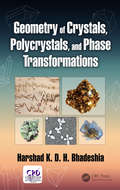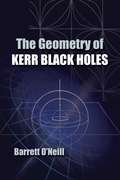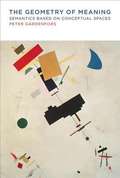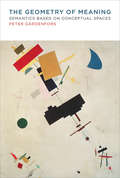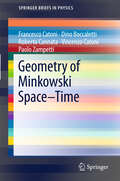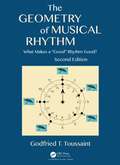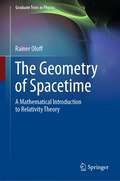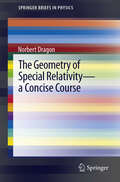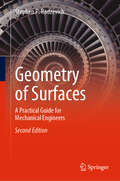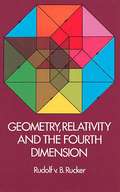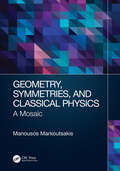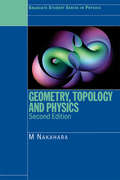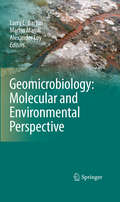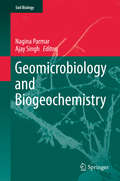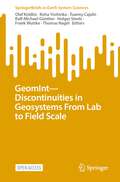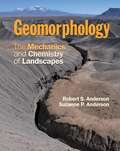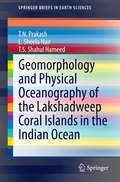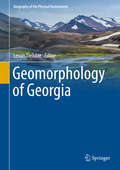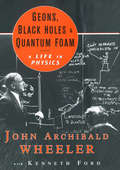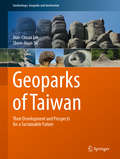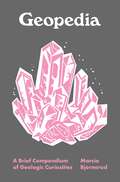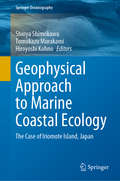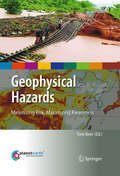- Table View
- List View
The Geometry of Celestial Mechanics
by Hansjörg GeigesCelestial mechanics is the branch of mathematical astronomy devoted to studying the motions of celestial bodies subject to the Newtonian law of gravitation. This mathematical introductory textbook reveals that even the most basic question in celestial mechanics, the Kepler problem, leads to a cornucopia of geometric concepts: conformal and projective transformations, spherical and hyperbolic geometry, notions of curvature, and the topology of geodesic flows. For advanced undergraduate and beginning graduate students, this book explores the geometric concepts underlying celestial mechanics and is an ideal companion for introductory courses. The focus on the history of geometric ideas makes it perfect supplementary reading for students in elementary geometry and topology. Numerous exercises, historical notes and an extensive bibliography provide all the contextual information required to gain a solid grounding in celestial mechanics.
Geometry of Crystals, Polycrystals, and Phase Transformations
by Harshad K. Bhadeshia<p>Organized into a two-part structure aimed at readers of differing experience levels, Geometry of Crystals, Polycrystals, and Phase Transformations is accessible to both newcomers and advanced researchers within the field of crystallography. The first part of the text covers what any reader in the material sciences, physics, chemistry, earth sciences and natural sciences in general should know about crystallography. It is intentionally concise and covers sufficient material to form a firm foundation. <p>The second part is aimed at researchers and discusses phase transformations, deformations, and interface crystallography in depth. The phase transformations are limited to those dominated by crystallography. The entire book contains worked examples and uniquely deals not just with crystals but aggregates of crystals and solid-state transformations between crystals.</p>
The Geometry of Kerr Black Holes (Dover Books on Physics)
by Barrett O'NeillThis unique monograph by a noted UCLA professor examines in detail the mathematics of Kerr black holes, which possess the properties of mass and angular momentum but carry no electrical charge. Suitable for advanced undergraduates and graduate students of mathematics, physics, and astronomy as well as professional physicists, the self-contained treatment constitutes an introduction to modern techniques in differential geometry. The text begins with a substantial chapter offering background on the mathematics needed for the rest of the book. Subsequent chapters emphasize physical interpretations of geometric properties such as curvature, geodesics, isometries, totally geodesic submanifolds, and topological structure. Further investigations cover relativistic concepts such as causality, Petrov type, optical scalars, and the Goldberg-Sachs theorem. Four helpful appendixes supplement the text.
The Geometry of Meaning
by Peter GärdenforsIn The Geometry of Meaning, Peter Gärdenfors proposes a theory of semantics that bridges cognitive science and linguistics and shows how theories of cognitive processes, in particular concept formation, can be exploited in a general semantic model. He argues that our minds organize the information involved in communicative acts in a format that can be modeled in geometric or topological terms -- in what he terms conceptual spaces, extending the theory he presented in an earlier book by that name. Many semantic theories consider the meanings of words as relatively stable and independent of the communicative context. Gärdenfors focuses instead on how various forms of communication establish a system of meanings that becomes shared between interlocutors. He argues that these "meetings of mind" depend on the underlying geometric structures, and that these structures facilitate language learning. Turning to lexical semantics, Gärdenfors argues that a unified theory of word meaning can be developed by using conceptual spaces. He shows that the meaning of different word classes can be given a cognitive grounding, and offers semantic analyses of nouns, adjectives, verbs, and prepositions. He also presents models of how the meanings of words are composed to form new meanings and of the basic semantic role of sentences. Finally, he considers the future implications of his theory for robot semantics and the Semantic Web.
The Geometry of Meaning: Semantics Based on Conceptual Spaces
by Peter GardenforsA novel cognitive theory of semantics that proposes that the meanings of words can be described in terms of geometric structures. In The Geometry of Meaning, Peter Gärdenfors proposes a theory of semantics that bridges cognitive science and linguistics and shows how theories of cognitive processes, in particular concept formation, can be exploited in a general semantic model. He argues that our minds organize the information involved in communicative acts in a format that can be modeled in geometric or topological terms—in what he terms conceptual spaces, extending the theory he presented in an earlier book by that name. Many semantic theories consider the meanings of words as relatively stable and independent of the communicative context. Gärdenfors focuses instead on how various forms of communication establish a system of meanings that becomes shared between interlocutors. He argues that these “meetings of mind” depend on the underlying geometric structures, and that these structures facilitate language learning. Turning to lexical semantics, Gärdenfors argues that a unified theory of word meaning can be developed by using conceptual spaces. He shows that the meaning of different word classes can be given a cognitive grounding, and offers semantic analyses of nouns, adjectives, verbs, and prepositions. He also presents models of how the meanings of words are composed to form new meanings and of the basic semantic role of sentences. Finally, he considers the future implications of his theory for robot semantics and the Semantic Web.
Geometry of Minkowski Space-Time
by Paolo Zampetti Vincenzo Catoni Roberto Cannata Francesco Catoni Dino BoccalettiThis book provides an original introduction to the geometry of Minkowski space-time. A hundred years after the space-time formulation of special relativity by Hermann Minkowski, it is shown that the kinematical consequences of special relativity are merely a manifestation of space-time geometry. The book is written with the intention of providing students (and teachers) of the first years of University courses with a tool which is easy to be applied and allows the solution of any problem of relativistic kinematics at the same time. The book treats in a rigorous way, but using a non-sophisticated mathematics, the Kinematics of Special Relativity. As an example, the famous "Twin Paradox" is completely solved for all kinds of motions. The novelty of the presentation in this book consists in the extensive use of hyperbolic numbers, the simplest extension of complex numbers, for a complete formalization of the kinematics in the Minkowski space-time. Moreover, from this formalization the understanding of gravity comes as a manifestation of curvature of space-time, suggesting new research fields.
The Geometry of Musical Rhythm: What Makes a "Good" Rhythm Good?, Second Edition
by Godfried T. ToussaintThe original edition of The Geometry of Musical Rhythm was the first book to provide a systematic and accessible computational geometric analysis of the musical rhythms of the world. It explained how the study of the mathematical properties of musical rhythm generates common mathematical problems that arise in a variety of seemingly disparate fields. The book also introduced the distance approach to phylogenetic analysis and illustrated its application to the study of musical rhythm. The new edition retains all of this, while also adding 100 pages, 93 figures, 225 new references, and six new chapters covering topics such as meter and metric complexity, rhythmic grouping, expressive timbre and timing in rhythmic performance, and evolution phylogenetic analysis of ancient Greek paeonic rhythms. In addition, further context is provided to give the reader a fuller and richer insight into the historical connections between music and mathematics.
Geometry of Quantum States: An Introduction to Quantum Entanglement
by Ingemar Bengtsson Karol ŻyczkowskiQuantum information theory is a branch of science at the frontier of physics, mathematics, and information science, and offers a variety of solutions that are impossible using classical theory. This book provides a detailed introduction to the key concepts used in processing quantum information and reveals that quantum mechanics is a generalisation of classical probability theory. The second edition contains new sections and entirely new chapters: the hot topic of multipartite entanglement; in-depth discussion of the discrete structures in finite dimensional Hilbert space, including unitary operator bases, mutually unbiased bases, symmetric informationally complete generalized measurements, discrete Wigner function, and unitary designs; the Gleason and Kochen-Specker theorems; the proof of the Lieb conjecture; the measure concentration phenomenon; and the Hastings' non-additivity theorem. This richly-illustrated book will be useful to a broad audience of graduates and researchers interested in quantum information theory. Exercises follow each chapter, with hints and answers supplied.
The Geometry of Spacetime: A Mathematical Introduction to Relativity Theory (Graduate Texts in Physics)
by Rainer OloffThis book systematically develops the mathematical foundations of the theory of relativity and links them to physical relations. For this purpose, differential geometry on manifolds is introduced first, including differentiation and integration, and special relativity is presented as tensor calculus on tangential spaces. Using Einstein's field equations relating curvature to matter, the relativistic effects in the solar system including black holes are discussed in detail. The text is aimed at students of physics and mathematics and assumes only basic knowledge of classical differential and integral calculus and linear algebra.
The Geometry of Special Relativity - a Concise Course
by Norbert DragonIn this concise primer it is shown that, with simple diagrams, the phenomena of time dilatation, length contraction and Lorentz transformations can be deduced from the fact that in a vacuum one cannot distinguish physically straight and uniform motion from rest, and that the speed of light does not depend on the speed of either the source or the observer. The text proceeds to derive the important results of relativistic physics and to resolve its apparent paradoxes. A short introduction into the covariant formulation of electrodynamics is also given. This publication addresses, in particular, students of physics and mathematics in their final undergraduate year.
Geometry of Surfaces: A Practical Guide for Mechanical Engineers
by Stephen P. RadzevichThis updated and expanded edition presents a highly accurate specification for part surface machining. Precise specification reduces the cost of this widely used industrial operation as accurately specified and machined part surfaces do not need to undergo costly final finishing. Dr. Radzevich describes techniques in this volume based primarily on classical differential geometry of surfaces. He then transitions from differential geometry of surfaces to engineering geometry of surfaces, and examines how part surfaces are either machined themselves, or are produced by tools with surfaces that are precisely machined. The book goes on to explain specific methods, such as derivation of planar characteristic curves based on Plücker conoid constructed at a point of the part surface, and that analytical description of part surface is vital for surfaces machined using CNC technology, and especially so for multi-axes NC machines. Providing readers with a powerful tool for analytical description of part surfaces machined on conventional machine tools and numerically controlled machines, this book maximizes understanding on optimal treatment of part surfaces to meet the requirements of today’s high tech industry.
Geometry, Relativity and the Fourth Dimension
by Rudolf RuckerThis is a highly readable, popular exposition of the fourth dimension and the structure of the universe. A remarkable pictorial discussion of the curved space-time we call home, it achieves even greater impact through the use of 141 excellent illustrations. This is the first sustained visual account of many important topics in relativity theory that up till now have only been treated separately.Finding a perfect analogy in the situation of the geometrical characters in Flatland, Professor Rucker continues the adventures of the two-dimensional world visited by a three-dimensional being to explain our three-dimensional world in terms of the fourth dimension. Following this adventure into the fourth dimension, the author discusses non-Euclidean geometry, curved space, time as a higher dimension, special relativity, time travel, and the shape of space-time. The mathematics is sound throughout, but the casual reader may skip those few sections that seem too purely mathematical and still follow the line of argument. Readable and interesting in itself, the annotated bibliography is a valuable guide to further study.Professor Rucker teaches mathematics at the State University of New York in Geneseo. Students and laymen will find his discussion to be unusually stimulating. Experienced mathematicians and physicists will find a great deal of original material here and many unexpected novelties. Annotated bibliography. 44 problems.
Geometry, Symmetries, and Classical Physics: A Mosaic
by Manousos MarkoutsakisThis book provides advanced undergraduate physics and mathematics students with an accessible yet detailed understanding of the fundamentals of differential geometry and symmetries in classical physics. Readers, working through the book, will obtain a thorough understanding of symmetry principles and their application in mechanics, field theory, and general relativity, and in addition acquire the necessary calculational skills to tackle more sophisticated questions in theoretical physics. Most of the topics covered in this book have previously only been scattered across many different sources of literature, therefore this is the first book to coherently present this treatment of topics in one comprehensive volume. Key features: Contains a modern, streamlined presentation of classical topics, which are normally taught separately Includes several advanced topics, such as the Belinfante energy-momentum tensor, the Weyl-Schouten theorem, the derivation of Noether currents for diffeomorphisms, and the definition of conserved integrals in general relativity Focuses on the clear presentation of the mathematical notions and calculational technique
Geometry, Topology and Physics
by Mikio NakaharaDifferential geometry and topology have become essential tools for many theoretical physicists. In particular, they are indispensable in theoretical studies of condensed matter physics, gravity, and particle physics. Geometry, Topology and Physics, Second Edition introduces the ideas and techniques of differential geometry and topology at a level suitable for postgraduate students and researchers in these fields.The second edition of this popular and established text incorporates a number of changes designed to meet the needs of the reader and reflect the development of the subject. The book features a considerably expanded first chapter, reviewing aspects of path integral quantization and gauge theories. Chapter 2 introduces the mathematical concepts of maps, vector spaces, and topology. The following chapters focus on more elaborate concepts in geometry and topology and discuss the application of these concepts to liquid crystals, superfluid helium, general relativity, and bosonic string theory. Later chapters unify geometry and topology, exploring fiber bundles, characteristic classes, and index theorems. New to this second edition is the proof of the index theorem in terms of supersymmetric quantum mechanics. The final two chapters are devoted to the most fascinating applications of geometry and topology in contemporary physics, namely the study of anomalies in gauge field theories and the analysis of Polakov's bosonic string theory from the geometrical point of view.Geometry, Topology and Physics, Second Edition is an ideal introduction to differential geometry and topology for postgraduate students and researchers in theoretical and mathematical physics.
Geomicrobiology: Molecular and Environmental Perspective
by Alexander Loy Larry L. Barton Martin MandlThis book is an interdisciplinary review of recent developments in topics including origin of life, microbial-mineral interactions, and microbial processes functioning in marine and terrestrial environments. A major component of this book addresses molecular techniques to evaluate microbial evolution and assess relationships of microbes in complex, natural communities. The function of microbial community members and their possible geological impact are evaluated from a perspective of (meta)genomics, (meta)proteomics, and isotope labeling. As well as summarizing current knowledge in various areas, it also reveals unresolved questions that require future investigations. These chapters enhance our fundamental knowledge of geomicrobiology that contributes to the exploitation of microbial functions in mineral and environmental biotechnology applications. Authors have provided skillful reviews and outlined unique perspectives on environmental microorganisms and their related processes.
Geomicrobiology and Biogeochemistry
by Nagina Parmar Ajay SinghOver the past 4 billion years, microorganisms have contributed to shaping the earth and making it more habitable for higher forms of life. They are remarkable in their metabolic diversity and their ability to harvest energy from oxidation and reduction reactions. Research on these microbiological processes has led to the newly evolving fields of geomicrobiology and biogeochemistry, linking the geosphere and the biosphere. This volume of the Soil Biology series provides an overview of the biogeochemical processes and the microorganisms involved, with an emphasis on the industrial applications. Topics treated include aspects such as bioremediation of contaminated environments, biomining, biotechnological applications of extremophiles, subsurface petroleum microbiology, enhanced oil recovery using microbes and their products, metal extraction from soil, soil elemental cycling and plant nutrition.
GeomInt—Discontinuities in Geosystems From Lab to Field Scale (SpringerBriefs in Earth System Sciences)
by Olaf Kolditz Keita Yoshioka Tuanny Cajuhi Ralf-Michael Günther Holger Steeb Frank Wuttke Thomas NagelThis is an open access book. In view of growing conflicts over strategic georesources, the use of the geological subsurface in the sense of a regional resource is becoming increasingly important. In this context, georeservoirs are playing an important role for the energy transition not only as a source of energy but also as a storage facility and deep geological disposal for energy waste. The success of the energy transition also depends to a large extent on the efficient and safe use of underground resources.This book complements the previous basic book (GeomInt—Integrity of Host Rocks) with a series of application examples in different rock formations, clay, salt, and crystalline. The methodology developed in GeomInt is used, among others, in the Mont Terri underground research laboratory (Opalinus Clay), in the large borehole test in Springen (salt rock) and in the “Reiche Zeche” teaching and research mine (crystalline rock). In addition, new methodological developments are also taken up in experiments and models and embedded in workflows for geotechnical system analyses. The present book summarizes the results of the collaborative project “GeomInt2: Geomechanical integrity of host and barrier rocks - experiment, modeling and analysis of discontinuities” within the program: Geo Research for Sustainability (GEO: N) of the Federal Ministry of Education and Research (BMBF).
Geomorphology
by Robert S. Anderson Suzanne P. AndersonThis textbook provides a modern, quantitative and process-oriented approach to equip students with the tools to understand geomorphology. Insight into the interpretation of landscapes is developed from basic principles and simple models, and by stepping through the equations that capture the essence of the mechanics and chemistry of landscapes. Boxed worked examples and real-world applications bring the subject to life for students, allowing them to apply the theory to their own experience. The book covers cutting edge topics, including the revolutionary cosmogenic nuclide dating methods and modeling, highlights links to other Earth sciences through up-to-date summaries of current research, and illustrates the importance of geomorphology in understanding environmental changes. Setting up problems as a conservation of mass, ice, soil, or heat, this book arms students with tools to fully explore processes, understand landscapes, and to participate in this rapidly evolving field.
Geomorphology and Physical Oceanography of the Lakshadweep Coral Islands in the Indian Ocean
by T. N. Prakash L. Sheela Nair T.S. Shahul HameedThe Lakshadweep islands are a group of 36 coral islands in the Indian Ocean. These small islands are unique for their aquatic bio-diversity and vast blue lagoons. This book presents the results of studies done by the authors during the period 1990 to 2009 that address the beach morphology, hydrodynamics, energy resources and management options with special reference to the issue of both natural and anthropogenic coastal erosion. The relatively low island elevation makes the islands more susceptible to high-wave attack and coastal flooding during adverse weather conditions. The islands are also prone to risks from episodic events like cyclones and deep depressions. This highlights the need for a comprehensive study of the wave, climate and coastal processes at work during different seasons to delineate the factors responsible for shoreline changes and also to identify the locations that need protection and the management options. This book will serve as a guide to researchers, scholars and students who are interested in the coastal processes of coral islands.
Geomorphology of Georgia (Geography of the Physical Environment)
by Levan TielidzeThis book provides a comprehensive overview of the geomorphology of Georgia. It describes a country characterized by geological, geomorphological and geographical diversities, located in the Caucasus region at the crossroads of Europe and Asia. This book is based on the results of several years of geomorphological studies and research in Georgia, published for the first time in English, and covers a gap in research in the field of world regional geomorphology. The landscapes of Georgia consist of high glacial mountains, medium and high mountains with deeply fragmented features, narrow and deep gorges and canyons, seaside lowlands, volcanic cones, uplands and mountain ranges, intermountain plains, hollows and highlands. The peculiarity of the landscape greatly affects the natural conditions. In several chapters, this book describes the diversity of climate, hydrographic network, vegetation cover, soils, fauna, exogenic processes, natural and anthropogenic landscapes. This volume provides the readers with the opportunity to explore the variety of landscapes and landforms in this diverse and fascinating country through informative texts illustrated with many color maps and photographs. Geomorphology of Georgia appeals to scientists, scholars, teachers and any readers interested in geology, physical geography, geomorphology, tourism and environmental protection. It is a rich resource for field trips and a comprehensive guide for travelers interested in the geomorphology of Georgia.
Geons, Black Holes, and Quantum Foam: A Life in Physics
by Kenneth Ford John Archibald WheelerThe autobiography of one of the preeminent figures in twentieth-century physics. He studied with Niels Bohr, taught Richard Feynman, and boned up on relativity with his friend and colleague Albert Einstein. John Archibald Wheeler's fascinating life brings us face to face with the central characters and discoveries of modern physics. He was the first American to learn of the discovery of nuclear fission, later coined the term "black hole," led a renaissance in gravitation physics, and helped to build Princeton University into a mecca for physicists. From nuclear physics, to quantum theory, to relativity and gravitation, Wheeler's work has set the trajectory of research for half a century. His career has brought him into contact with the most brilliant minds of his field; Fermi, Bethe, Rabi, Teller, Oppenheimer, and Wigner are among those he called colleagues and friends. In this rich autobiography, Wheeler reveals in fascinating detail the excitement of each discovery, the character of each colleague, and the underlying passion for knowledge that drives him still.
Geoparks of Taiwan: Their Development and Prospects for a Sustainable Future (Geoheritage, Geoparks and Geotourism)
by Jiun-Chuan Lin Shew-Jiuan SuThis book offers an essential introduction to Taiwan’s geoparks, issues related to their development, and prospects for a sustainable future. It discusses how promoting geoparks can serve as a tool for a sustainable society based on the lessons learned in Taiwan. Situated in a tectonically dynamic geological setting (at the boundary of the Eurasian and the Philippine Plates) and culturally diversified geographical setting, Taiwan is an ideal candidate for showcasing its “natural wonders” in geoparks, promoting landscape conservation, and expanding the horizons of geoheritage world-wide. The book begins by illustrating the physical and human environments of Taiwan’s geoparks, helping readers understand their foundation. In turn, the second section includes chapters describing the development of all six Taiwanese geoparks, offering comprehensive information on each. Lastly, it illustrates the social development and mechanisms used to promote each geopark.
Geopedia: A Brief Compendium of Geologic Curiosities (Pedia Books #6)
by Marcia BjornerudA garden of geologic delights for all EarthlingsGeopedia is a trove of geologic wonders and the evocative terms that humans have devised to describe them. Featuring dozens of entries—from Acasta gneiss to Zircon—this illustrated compendium is brimming with lapidary and lexical insights that will delight rockhounds and word lovers alike.Geoscientists are magpies for words, and with good reason. The sheer profusion of minerals, landforms, and geologic events produced by our creative planet demands an immense vocabulary to match. Marcia Bjornerud shows how this lexicon reflects not only the diversity of rocks and geologic processes but also the long history of human interactions with them.With wit and warmth, she invites all readers to celebrate the geologic glossary—a gallimaufry of allusions to mythology, imports from diverse languages, embarrassing anachronisms, and recent neologisms. This captivating book includes cross-references at the end of each entry, inviting you to leave the alphabetic trail and meander through it like a river. Its pocket-friendly size makes it the perfect travel companion no matter where your own geologic forays may lead you.With whimsical illustrations by Haley Hagerman, Geopedia is a mix of engaging and entertaining facts about how the earth works, how it has coevolved with life over billions of years, and how our understanding of the planet has deepened over time.Features a real cloth cover with an elaborate foil-stamped design
Geophysical Approach to Marine Coastal Ecology: The Case of Iriomote Island, Japan (Springer Oceanography)
by Shinya Shimokawa Tomokazu Murakami Hiroyoshi KohnoThis book presents recent results of collaborative studies in geophysics and ecology, focusing on the relationship between the physical environment and the distribution of the marine coastal ecosystems. The study area, the Sakiyamawan–Amitoriwan nature conservation area in Iriomote Island of Japan, is the only oceanic nature conservation area in the country. The area has no access roads, and the bay perimeter is uninhabited; therefore, it preserves the natural environment with very little human impact. In addition, it has various environmental gradients such as topography and inflows from rivers with mangrove forests which affect the distribution of marine coastal ecosystems such as those containing reef-building corals, sea grasses, and hermit crabs. For these reasons, the area is one of the best places for the study of the relationship between the physical environment and the distribution of the marine coastal ecosystems, a relationship that is important for their conservation but has not been investigated fully. This book is aimed at students and researchers in the fields of oceanography and marine coastal ecology as well as general readers who are interested in coral reefs, diving, and nature conservation.
Geophysical Hazards
by Tom BeerThis volume, written by the Hazards Science Team of the International Year of Planet Earth, brings together some of the most influential international scientists dealing with Natural Hazards and Society's response to natural hazards. It recognises that hazards, like poverty, will always be with us but that concerted and organised societal response can prevent a hazard becoming a disaster. By bringing together geoscientists, social scientists and those concerned with the administration of international science and international disaster reduction, this book details the state-of-the-science as well as the state-of-the-response in natural hazards.

